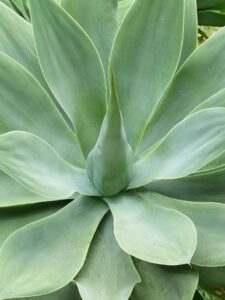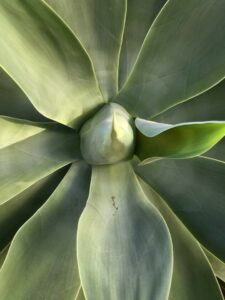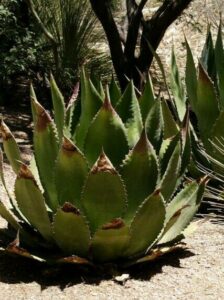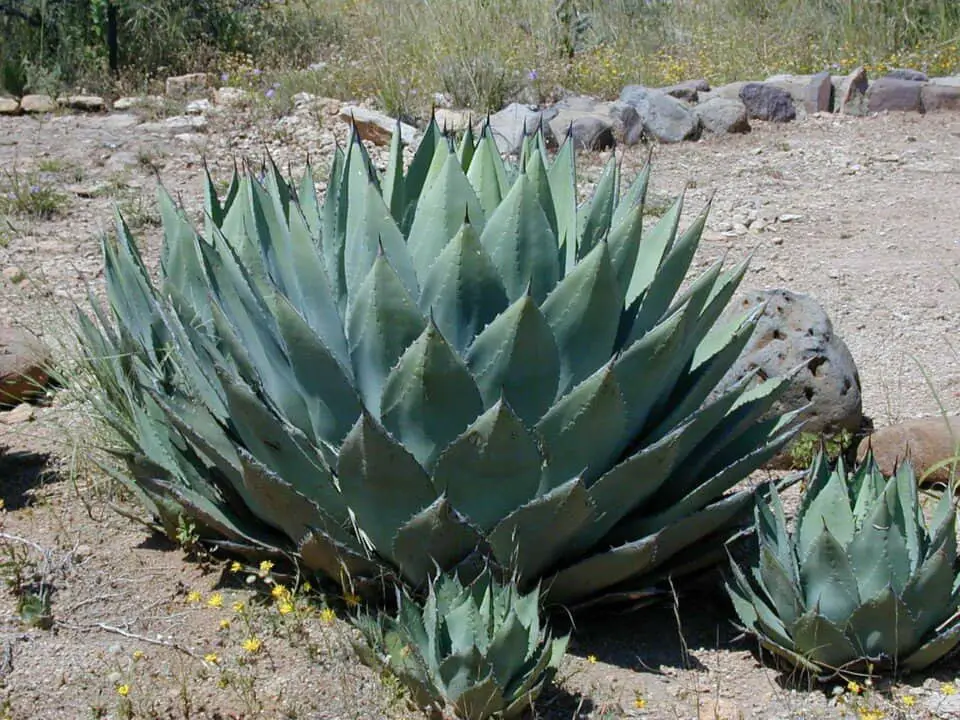Some links in the post are affiliate links and I get a commission from purchases made through some links found in the post.
Agave plants seem to have a special place in many gardens. They are native to hot areas such as the Americas, although they are also found in some tropical regions.
Agave are classed as succulents and apart from spongy leaves, they often produce large rosettes made up of fleshy leaves.
These plants can grow anywhere between 10’ high right own to small versions which can be displayed on windowsills in small bowls. Their colours vary from blue/green to grey/green depending on the climate you grow them in.
Most gardens grow agave for their foliage rather than their flowers, and while they do flower after several years, this is not the main reason for their beauty. Unfortunately, after the plant has flowers it normally dies.
The foliage of the Agave is dramatic and strikingly beautiful, and you would think with these unusual plants that there is a definite maintenance routine to keep them at their best.
This may be the reason why some people are less inclined to use Agave as focal points.
An interesting point here is that Agave plants simply thrive on neglect! Yes, you read that right – they do extremely well when they are lift alone.
There are very few requirements and once these are taken care of, the plant will do well and become a centre of attention in most gardens.
Now while Agave do need some attention – as does every plant we grow – this is not anything to be afraid of. We’ll cover exactly what your Agave needs to thrive and keep its rightful place in your garden.
What Soil Nutrients do Agave Need?
 Although your Agave plant will be happy in any well-draining soil or potting mix, they would far rather you set them in rocky or sandy soil. This will drain far better than any potting mix.
Although your Agave plant will be happy in any well-draining soil or potting mix, they would far rather you set them in rocky or sandy soil. This will drain far better than any potting mix.
If you prefer you can use a potting mix which is designed for using with cacti and succulents as this will be made of well-draining materials and be well suited to Agave plants.
It will also contain the nutrients suitable for Agave plants so you will not need to fertilize your Agave.
Agave plants need well-draining soil to prevent root rot, which will kill your plant. Additionally, the soil should be slightly acid to neutral in the pH value.
What Type of Soil Should you Use for your Agave?
Any soil you use in a pot for your Agave should dry slowly but drain quickly. In pots placed outdoors you can use a mixture of soil using equal parts of potting mix or garden soil and adding either gravel or coarse sand.
Peat moss is entirely unsuitable for Agaves as this retains the water and the plant will develop soggy roots and die.
Your Agave plant is not fussy about the soil or potting mix you grow it in, but it is fussy about the drainage in the pot. Unless the excess water can easily drain away, your plant will suffer and possibly die of root rot.
It is best to err on the side of bad soil than pamper your plant with regular potting mix which may work for many other plants but not for your Agave.
If you cannot obtain a suitable potting mix, then you may also add small gravel stones to your soil as this will help with draining any excess water away.
Remember that your Agave thrives on neglect! Adore and admire it from afar, and then leave it alone!
What are the Signs you are Using the Wrong Soil for your Agave?
The most common issue with Agave plants is all related to the soil and the amount of water the plant receives. Most problems with Agave stem from this.
Remember that your Agave thrives in ‘rubbish’ soil and in this case, too much of a good thing is very bad for your plant.
One of the issues that come from overwatering, lack of drainage and boggy roots is Anthracnose and for Agave plants this is bad news.
Anthracnose is a fungal disease (not always fatal in Agave plants), and it thrives when conditions are wet and humid. It also occurs when the plant is in too much shade or is watered excessively.
The sign to watch out for with this infection include ugly sunken lesions which show up on the crown and the leaves.
They often have a red/brown spore mass and spreads easily from one plant to the next through splashing water or rain during wind.
Although fungicides can be effective, you are far better preventing this infection from taking a hold. Plant your Agave in full sunlight, using well-draining soil. Avoid using overhead sprinklers which will encourage the infection.
Additionally, make sure that there is plenty of space between your Agave plants so that the air can circulate. Remove and destroy infected plants right away and never use the dead plants in the compost heap.
Other signs of using the wrong soil are leaves which become floppy and bendy. This is also due to overwatering and lack of drainage.
How to Keep your Agave Happy
 Make sure you only use a well-draining soil mix. Ideally this should be 50% compost and 50% perlite or grit.
Make sure you only use a well-draining soil mix. Ideally this should be 50% compost and 50% perlite or grit.- Plant in a direct sunlight spot for best growth rate.
- You can also plant the Agave at an angle so that the crown does not hold water. This is important in very rainy seasons when you may want to tip the entire pot over to one side so that there is no build-up of water.
- Make sure that any container you use for your Agave has drainage holes in the base. If not, either choose another pot or drill some holes in the bottom.
- Ceramic pots are a good choice because they allow excess water to evaporate through the sides while plastic pots may sweat and retain moisture.
What PH should the soil be for your agave?
If in any doubt you should have the soil tested where you intend to plant your Agave.
The pH should be between 6.6 and 6.8.
You should, however, also take a good look at your Agave and if the plant is doing well, then the pH is most likely to be correct. You will know very soon that your Agave is not happy with its soil.
Our 5 recommended soils for an Agave
1) Sun GRO Horticulture 1410602.Q08P Black Gold Cactus Mix (8 qt) (2 Pack)
This mix has been specially developed to suit the growing needs of succulents. There are no additives in the mix which consists of perlite, pumice, sand, and forest humus. It is not too rich, but perfectly suitable for these plants.
Because the mix also contains earthworm castings the drainage is excellent and the soil structure perfect for Agave plants and any other succulents.
You can also use this mix on bromeliads and any type of cactus.
2) Premier Horticulture 1008081RGCE Premier Organic Cactus Mix, 8 Quarts
This ready to use mix consists of a peat-based cactus mix. It is fast draining so perfect for both succulents and cacti. It provides optimum air porosity while still retaining just enough water for the plants.
The mix is also treated with a gnat repellent ingredient and is fungus resistant.
This potting mix is suitable for plants which are kept both indoors and outdoors.
3) Espoma Organic Cactus Potting Soil Mix, Natural & Organic Soil for Cactus, Succulent, Palm, and Citrus grown in containers both indoors and outdoors, 4 qt, Pack of 1
This potting mix contains a mixture of sphagnum peat moss, perlite and humus and provides optimum aeration as well as excellent drainage qualities.
The mix can be used for a variety of plants, namely all succulents, cactus, palms, and citrus. Aloe Vera, Agave, Christmas Cactus, Jade Plants and Barrel cactus will all benefit from the rich, proprietary blend of endo and ecto mycorrhizae.
You can use the mix at any time, whether you are planting a new plant or transplanting an older one into a larger pot.
The mix contains a blend of the finest natural ingredients, with no synthetic plant foods or chemicals included.
4) Fertilome Cactus and Succulents Mix 4 Quart Bag
Here we have a mix made up of Canadian sphagnum peat moss, horticultural perlite, calcitic limestone, sand, dolomite limestone along with a starter nutrient and a wetting agent.
The mix is designed to closely replicate conditions where plants such as Agave grow, namely in arid environments.
The mix drains well due to the higher ratio of perlite it contains.
5. Anothera 18LB Succulent and Cactus Bonsai Gritty Mix Rocks, DIY Additive Pre-Mixed Faster Draining Blend, No Root Rot (Sunset Red)
This gritty mix drains very well and is designed for use with both succulents and cactus. The well- draining mix ensures that there will never be any standing water for these plants.
While the mix drains well, it still provides the necessary nutrition for cactus and succulents and added to any regular soil will help to adjust the pH of the soil.
The mix comes in different colours so can also be used as a top layer for plants.
How Much Soil Does an Agave Need?
So, as we’ve discovered, Agave plants thrive in soil which many other plants cannot handle. In fact, the worse the soil, the better they seem to do.
Truthfully your Agave does not need a lot of soil at all. What it does need is a mix that drains well and a container which is solid enough to prevent them from being knocked over or blown over in strong winds.
Unglazed pots are ideal for these plants because they help excess water to evaporate through the sides.
How to re-pot an agave
- Choose your new pot and make sure that there are drainage holes in the base.
- Now fill it with the mix you plan on using.
- Dig a hole in the mix about the same size as the pot you are transplanting it from.
- Place your plant in the hole and cover the roots with new mix.
- Press down gently to make sure that the potting mix does not have any air pockets in it and that the roots are firmly embedded in the mix.
When Should I Repot my Agave?
Because Agave plants simply love to be root bound you may not ned to re-pot them every year. The reason to re-pot annually is to replenish the nutrients in the potting mix, rather than because the plant is too large for the pot.
Once a year inspect your Agave and decide if it needs new potting mix. If so, go ahead and re-pot it. You can quite happily leave your Agave for two years before re-potting it and it will come to no harm at all.
Final Thoughts
 Agave plants grow best in desert conditions. They far prefer zones where the winters are mild to areas where the winters are brutal. They survive very well in drought conditions and can grow in soil which is not generally good for many other plants.
Agave plants grow best in desert conditions. They far prefer zones where the winters are mild to areas where the winters are brutal. They survive very well in drought conditions and can grow in soil which is not generally good for many other plants.
In other words, Agave plants are low maintenance and can do well pretty much anywhere you want to place them.
As long as the soil and potting mix you use is well-draining, your Agave plant will grow well.
Because they are so versatile they are suitable for patios, in the ground and even in areas where there is less than a full day’s sunlight.
Basically, pop your Agave into a pot and move it to wherever you think it looks good and you will be rewarded with a great specimen which will last you for many years.
You don’t even need to re-pot your Agave plant every year as it will be perfectly happy with its roots inside a small pot.
Considering all this, it is no wonder why Agave plants are so popular with gardeners the world over.






